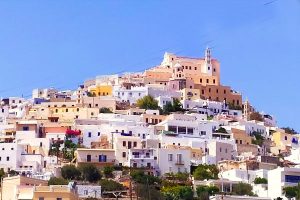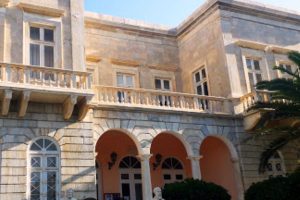Information about the island of Syros

The capital of the island of Ermoupolis still looks like an open-air museum, a living monument of neoclassical architecture with relics and cultural treasures worth discovering.
From the medieval city in Upper Syros, the ancient monuments of the Proto-Cycladic era in Kastri, the Apollo theater, the Orthodox and Catholic coexistence, but also the various Asia Minor touches to the machine shop in Neorio Syros which operates from 1861, Syros is a unique place of inexhaustible historical tradition and culture.

One of the great peculiarities of Syros is the characteristic coexistence of the Orthodox and the Catholic faiths, a truly special coexistence that transmits the cosmopolitan and liberal character of the island to all of the Cyclades. From one end to the other, Catholic churches, Orthodox churches and chapels that seem to float between earth and heaven invite the faithful to pray and experience the ultimate immersion.

Following the lacy coastline one can choose to swim at one of the popular organized beaches of Syros or spend the day at one of the sandy beaches or relax at one of the more exotic and secluded beaches.
In Syros with its 29 picturesque settlements that successively create a set of impressive images with medieval references, Cycladic symmetry and authentic touches from the glorious past.
Geography of the island

To the northwest are Kea and Gyaros, to the west Kythnos and to the southwest Serifos. To the south are Sifnos, Antiparos, Paros and Naxos. The northern part of Syros is mountainous and inhabited by few inhabitants.
This part of the island is of particular interest because it differs morphologically from the rest. It is the only place that has limestone rocks, unlike the rest of the island which is covered by volcanic rocks. It has few roads and marked trails but contains landscapes with rocks, bridges and caves.
From these paths you can access the northern beaches of Syros which, due to the lack of roads, are deserted and ideal for isolation and tranquility. The southern part is flat and there are most of the villages and the most famous beaches of the island. The settlements there are developed for tourism, and the road network is quite good. The capital Ermoupolis is located on the eastern side of the island.
Flora and fauna

In the southern part of the island, residential development becomes more evident and coexists with rich vegetation, the main feature of which are the local stands of pine trees. The fauna of Syros is also of great interest. In addition to the goats climbing the dry rocks and scrambling down the rocks to the sea, the more initiated can observe birds, reptiles, amphibians, hares and rabbits. Throughout the island, and mainly in Apano Meria, 11 species of reptiles, the green toad (a type of amphibian) and 47 species of birds are endemic.
Economy
Today, Syros appears to be highly developed economically, a development that is based on many different sources.
Tourism, the operation of the shipyard, the now high agricultural production, the presence of many public services and the operation of the Product and Systems Engineering Department of the University of the Aegean contribute decisively.
Life in Ermoupolis remains alive throughout the winter and there are very few shops that stay open only for the summer season.
History
Syros had already been inhabited since prehistoric times (3rd millennium BC), as evidenced by finds in the areas of Chalandriani and Kastri. Especially in Chalandriani, more than 600 tombs with offerings were found, while in Kastri a fortified settlement with significant urban and commercial activity was found.
Also, some finds are convincing for the existence of metalworking workshops and testify to the relations of Syros with the coasts of Minoria at that time. From the investigations, traces of facilities were also found in other parts of the island.
During the 2nd millennium BC, Syros seems to have passed successively under the control of Minoan Crete, Mycenae and finally, at the beginning of the 1st millennium BC, the Ionians.
The people
Once you set foot on the island and start mingling with the locals, wander the streets of Hermoupolis with its fascinating Public buildings and mansions. When you start your excursions in the small villages with the still-intense rural life today or when you find yourself once in the winter pig slaughterhouses with the tsambounas and doupakis playing non-stop giving the rhythm to the primordial custom, you realize that apart from the obvious harmony of coexistence of Catholics and Orthodox that have contributed to the creation of a peculiar social and cultural structure is clearly visible.
Local cuisine and gastronomy
If someone takes a closer look, he will find that the coexistence of refined urban cuisine with that of rural and animal husbandry is equally interesting, expressed in simple but interesting dishes such as pork sausages with fennel seeds, grilled meatballs, dried capers cooked with tomato accompanying fried fish, caper salad, fennel pie and dried tomatoes.
Loukoumia

The first loukumi were made by Chios like Stamatelatos, Passaris and Denaxas with black raw sugar. It is even said that the element that made the Syrian loukumi unbeatable is the island’s brackish water.
Halvadopites
Halvadopites were made for the first time on the island in 1840 and are considered, together with loukumi, the island’s trademark. It could be described as a kind of “sandwich” dessert. Its ingredients, which are closed between two transparent “hosta” leaves, are: sugar, glucose, vanilla flavoring, honey, egg whites and whole roasted almonds. The more almonds, the better halvado pies. Today, of course, you can also find them in many different flavor variations, such as with pistachios and even chocolate.
Louza sausages
Pork sausages, common throughout the Cyclades, in Syros is made from pork loin, which is marinated in red wine and seasoned with pepper, cloves, allspice and cinnamon. It is placed inside a natural gut and hung in the air to dry and mature for 40 days.
What to see
Upper Syros

The settlement of Ano Syros is a typical example of the era in which it was created. For practical reasons related to their protection from raids, the then inhabitants built their houses in such a way that the outer walls were a natural fortification.
The small narrow paved streets and the roofs in addition to saving space, provided the residents with the possibility to hide and protect themselves more easily from danger, while the central entrances of the settlement were closed with wooden doors and secured the residents from a possible night raid.
The Town Hall of Syros

The Town Hall is the work of the German architect Ernesto Ziller, founded in 1876 and inaugurated in 1898. In addition to the municipal services, the Town Hall houses the courts, the Archaeological Museum and the Historical Archive of Cyclades and other public institutions. .
Miaouli Square is one of the rare 19th century squares in Greece. The original name, “Othonos Square”, was given in honor of the first king of Greece. The current name was given in 1889, when the statue of Andreas Miaoulis was unveiled.
The Apollo Theater

The work to complete its construction was completed in 1864, with plans by the Italian architect of the Club, Pietro Sampo, and the Apollo theater is one of the most impressive architectural ornaments of Syros, while it is considered a miniature of the Milanese staircase.
The Apollo Theater is a two-story building, with a capacity of three hundred and fifty spectators, with a low marble base and plastered facades. Inside the building, the hall is majestic, has four rows of theory, while the rich frescoes on its decorated ceiling, with original painting subjects, depict famous European creators of Music and Theater (Verdi, Rossini, Bellini, Donizetti , Mozart, Dante, Euripides and Homer) and in the square the red velvet seats add glamor to this unique gem of Ermoupolis.
The Library of Ermoupolis

In the library you will find a large collection of local press starting from the last century and reaching the present day. Also, some of the valuable old books such as the “Argonautica” of Apollonius of Rhodius of 1521, the “Onomastico tou Polydeukus” of 1608 by Rakina, the “Justinianai” of Prince Rodokanakis rare Syrian edition, etc. are kept in a separate location.
The Vaporia district

The church of Agios Nikolaos in Vaporia stands out for its “pure” beauty but also for its surroundings where the stone lion is located, a monument to the unburied fighters of Greece. Shortly after the temple, enjoy the secular “Asteria”, the waterfront that many Hermoupolitans prefer for their swimm and their night out.
The Syros Casino
In Syros you can also try your luck. The Syros Casino started its operation in April 1997 in a traditional building of 1830 where the “Europa” hotel was housed. With the restoration of the building, all the historical and Cycladic elements were highlighted, creating a real gem.
The Lighthouse of Syros

Its monumental character – it has a building height of 29.5 meters and is 68.3 meters from the sea – is not justified by its function, since it is not a cape lighthouse but is connected with the first tour of King Otho to the Aegean islands in 1833 and the desire of the Hermoupolitans to emphasize the importance of the port and secure its place in the national context.
Neorio the shipyard

Its history begins in 1861, when Greek steam shipping established in Ermoupolis the first – and only at that time – steam-powered ironworks in Greece and in the wider area of the eastern Mediterranean. Initially, the factory manufactured small steam engines, pumps, boilers and similar components, having at its disposal a wooden dock built in 1857 by the Chios shipbuilder Nikolaos Pagidas, and then a second one, also wooden, granted by the French company Companie des Forges et Chantiers.
The Aquarium
The aquarium in Kini is a particularly interesting attraction as it gives visitors the opportunity to get to know the enchanting marine world of the Aegean Sea up close and to study the marine flora and fauna in depth.
In the aquarium you will learn everything about the sea, about the marine activities of the Syrians and the tools used in them. In addition, they will have the opportunity to admire the exhibits of the Museum of Traditional Boats, Fishing Tools and Marine Organizations hosted in the same space
Ermoupolis

From the impressive Town Hall in Miaouli Square, inspired by Ernest Ziller and the palaces of Troy, the Apollo Theater, the mansions that dominate the aristocratic Vaporia district, the municipal library and the island’s admirable museums, the Church of the Resurrection and the other beautiful Orthodox and Catholic churches, the image of Hermoupolis evokes something much more than a beautiful island capital, it evokes an open-air museum worth exploring from end to end.

It is a cosmopolitan capital with its own special character, a vibrant city that buzzes with life throughout the year. Ermoupoli has an excellent tourist infrastructure and offers a wide variety of infrastructure for accommodation, dining, entertainment and relaxation for all visitors with a variety of accommodation options, cafes, restaurants and bars, as well as an abundance of sports and cultural activities.
The main cultural institution of the island and a point of reference for visitors is the Syros Culture festival which takes place every year during the summer and gives an even more impressive cultural aspect to the island. Ermoupoli is the central port of the island which connects daily with the ports of Piraeus, Rafina, the Cyclades and the North Aegean, while the island’s airport is 3 km away.
Ano Syros

From here you will see Ermoupoli panoramically and you will fall in love with it. In Lili, Apanachoritissa and Maison De Meze you will taste local delicacies. At Hyma and Tsouvalata you will get a souvlaki in your hand and at Theosis and Braziliana you will enjoy your favorite summer drinks.
Picturesque streets, courtyards full of bougainvillea, tiny churches, Cycladic architecture, Venetian charm, nice traditional taverns… The walk here against the backdrop of a unique Aegean picture is a wonderful experience!
Beaches

Ampelas on the south side of the island with the small picturesque beach with fine sand and the shade of tamarisk trees. Vari, at the south-eastern end of the island, has an organized beach with the characteristic tower. On the eastern side of the island, at the closest distance from Hermoupolis, Azolimnos has experienced the greatest tourist development in recent years. Galissas, on the other hand, on the west side of the island with a very beautiful beach with fine sand and natural shade from the tamarisk trees.
Finikas is located in the southwestern part of Syros, having a natural harbor with an organized marina, while its beautiful, open beach has golden sand. Finally, Kini on the western side of Syros, is a picturesque coastal fishing village, with a very well organized sandy coast.
Where to stay
Syros stands out for its proposals for accommodation. The island is mostly visited by Greek tourists, many have second homes and even when they go to the hotel they book in advance. Choose Ermoupouli if you want to feel the pulse of a vibrant Greek city or the other villages if the priority is to have the beaches just a few meters from the hotel.In addition to the excellent hotel check out the beautiful 5-star Castro Hotel in Ermoupoli, the also 5-star, Aristidis Hotel with private plunge pools, sea view, bar in top floor, garden and art gallery but also the elegant Oro Suites in the beautiful Kini of Syros. Soul Luxury Suites, in Ermoupoli, a few steps from Miaouli Square, is also excellent. Another proposal in Kini, is the Pino di Loto hotel, in front of the beach, the hotel offers suites overlooking the Aegean Sea.
How to get there
There are frequent ferry routes from Piraeus, Rafina as well as the nearby islands. You can easily and comfortably travel by ferry from Piraeus, Rafina and the surrounding islands to Syros. The journey from Piraeus to Syros takes about 3 hours and 30 minutes by conventional ferry, while by speedboat it takes about 2 hours. In the summer there are also ferry routes from Rafina to Syros and the journey takes about 4 hours.
Tickets to Syros start from 25 euros, with a conventional ferry, while with a speedboat the price starts from 50 euros. However, it is good to keep in mind that ticket prices may fluctuate depending on the port of departure, the type of ship, whether you will be traveling with your vehicle, the offers and discounts.

